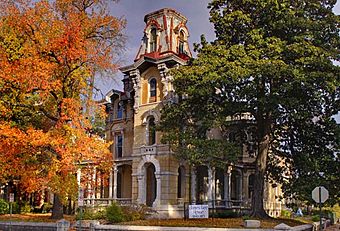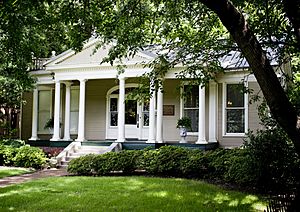Victorian Village, Memphis facts for kids
Quick facts for kids |
|
|
Victorian Village District
|
|

Harsson-Goyer-Lee House, 690 East Adams Street
|
|
| Location | Adams and Jefferson Sts., Memphis, Tennessee |
|---|---|
| Area | 28 acres (11 ha) |
| Architect | Multiple |
| Architectural style | Greek Revival, Late Victorian, Italianate |
| NRHP reference No. | 72001253 |
| Added to NRHP | December 11, 1972 |
The Victorian Village District is a special neighborhood in Memphis, Tennessee. It's famous for its beautiful old houses built a long time ago. These homes show off the amazing architecture from the 1800s.
Contents
Exploring Victorian Village Homes
The Victorian Village is located on the eastern side of downtown Memphis. It's like stepping back in time to see how people lived over a hundred years ago.
A Look Back at History
In the mid-1800s, Memphis was growing fast. Rich families decided to build large, fancy homes just outside the city center. These homes in Victorian Village were built between 1846 and the 1890s. They show different styles, from classic Greek Revival to detailed Late Gothic Revival.
Two important architects, Edward C. Jones and Matthias Harvey Baldwin, designed some of these homes. They built the Woodruff-Fontaine House in 1870. They also updated the Harsson-Goyer-Lee House in 1871.
Famous Houses in the Village
- Massey House: This is the oldest house in the area, built around 1846. It was made for Benjamin A. Massey, who was an early lawyer in Memphis.
- Mallory-Neely House: Built in 1852, this house looks like an Italian villa with a tall tower. It was first built for a banker named Isaac Kirtland. Later, it was made much bigger and fancier in the 1880s and 1890s. Inside, you can still see many of the original furnishings from the late 1800s.
- Harsson-Goyer-Lee House: Located at 690 Adams Street, this house was once owned by James Lee, who owned riverboats. Charles Goyer, who helped start Union Planters Bank, made it bigger in 1871.
- Pillow-McIntyre House: This two-story Greek Revival home was built around 1852. In 1873, General Gideon Pillow, a hero from the Mexican War and the Civil War, bought it. This unique Victorian house was empty for many years. But with help from donations, it was beautifully fixed up in 2004.
- Woodruff-Fontaine House: Built in 1870, this house has a French-Victorian style. It was built by Amos Woodruff, who was a successful businessman and politician. The next owner, Noland Fontaine, was a cotton trader at the Memphis Cotton Exchange. In 1936, the house was given to the city. Later, it became an art school. In 1961, a group called the Association for the Preservation of Tennessee Antiquities took over. They restored the house with furniture and fabrics from the 1800s. There's even a cute Victorian-style playhouse on the property!
The Annesdale-Snowden Historic District
The Snowden home is in a nearby historic area called Annesdale-Snowden. In 1850, Dr. Samuel Mansfield built this beautiful "Italianate villa" on his 200-acre farm outside Memphis. The house was on a hill above the main road to Mississippi.
In 1869, Colonel Robert C. Brinkley bought the estate. He gave it as a wedding gift to his daughter, Annie Overton Brinkley, and her husband, Colonel Bogardus Snowden. They named the estate Annesdale after her.
In the early 1900s, Colonel Snowden and his sons built two new neighborhoods on the estate. Annesdale Park (1903) was said to be the first of its kind in the South. Snowden Homestead (1910) followed. The streets in these rich neighborhoods were named after the Snowden children. Famous people like Memphis entrepreneur Kemmons Wilson lived there. After World War II, the area slowly changed. But in the 1970s, people started fixing up the homes again. It was listed on the National Register of Historic Places in 1979. The Snowden home is not open to visitors.
Victorian Village Today
Today, some of these large, three- and four-story mansions are still standing near downtown Memphis along Adams Avenue. While many original homes are gone, several are now museums you can visit:
- The Magevney House (198 Adams)
- The Mallory-Neely House (652 Adams)
- The Woodruff-Fontaine House (680 Adams)
The Magevney House is open on the first Saturday of each month from 1 PM to 4 PM, and it's free to enter. The Mallory-Neely House is open on Friday and Saturday from 10 AM to 4 PM. After being empty for over 60 years, the Harsson-Goyer-Lee House has been beautifully fixed up and is now a fancy Bed and Breakfast. The Woodruff-Fontaine House is open Wednesday through Sunday from 12 PM to 4 PM. It's a popular place for weddings and private parties.
The entire Victorian Village neighborhood is recognized as a special place and is listed on the National Register of Historic Places.
Homes That Need Help
Some homes in the area are considered "endangered" by Memphis Heritage. This is a group that works to save old buildings. The Lowenstein-Long House (1901) at 217 N. Waldran Blvd. and the Lee-Macintyre House in Victorian Village are two homes they are trying to protect.





